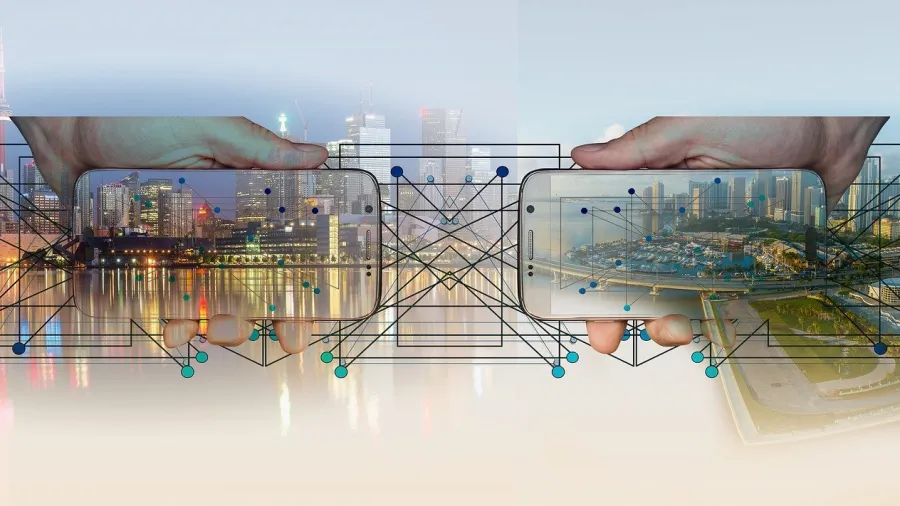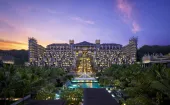
How Surbana Jurong uses sensors to make buildings smarter—and safer
With Smart Digital Spaces, building facilities can be digitally maintained while improving workplace productivity, air quality, safety, and quality of life.
A key tenet of Singapore's Construction Industry Transformation Map is the transition of a labour-intensive Facilities Management industry in the Built environment sector to a higher value one powered by data analytics, predictive maintenance, and smart solutions. As a global urban, infrastructure, and managed services consulting firm, Surbana Jurong plays a key role in this transition. The company leverages 30 years of experience deploying digital applications in Singapore's public housing and large-scale infrastructure projects to design and build smart and sustainable spaces for its clients.
"Smart Digital Spaces is a term we coin for spaces that are equipped with technologies and IoT sensors to digitise processes such as Facilities Management (FM) processes,” explained Eugene Seah, managing director for smart city solutions and senior director for special projects at Surbana Jurong.
“We channel data derived from the sensors to a Common Data Environment (CDE) platform which we call “24K Integrated Platform” (24K) to perform predictive maintenance for different asset types and to gain better insights from the data so that our clients can optimise their operational cost of maintaining their assets, while at the same time reducing their carbon footprint. This platform has machine learning capabilities and visualisation tool which will cater to the needs of the various user profiles”.
SJ’s 24K system is an agnostic, plug-and-play platform that houses its enterprise-level digital facilities management system, OMNI. The IoT sensors are plugged into OMNI and visualised on a dashboard. For smaller spaces, SJ has a Pocket FM solution which is a lighter version of OMNI.
Displaying all the data streams from temperature, humidity, occupancy sensors deployed in a space allows building managers to ensure the health and safety of the users of a particular building are not compromised. For an asset owner, digitising the management of spaces means the ability to have better control of costs and being able to set realistic goals to meet sustainability targets.
Super Low Energy, Net Zero Carbon Achievable
Aside from playing a critical role in the fight against climate change, these sensors can surgically rectify mechanical & electrical faults in lifts, pumps, and air-conditioning systems. Building managers have on-hand mobile apps where they can access the entire dashboard showing the data streams from the various sensors in real-time. This optimises the number of building technicians required on-site to monitor the asset since they are only deployed when they are alerted to a problem.
At a more advanced level of digitisation, building managers are able to analyse data to identify common faults and rectify them ahead of time. This type of predictive maintenance will reap additional savings in operational and utility costs, which in turn reduces the carbon footprint in space. Data on space usage patterns help asset owners re-design spaces to lock in lower operational and utility costs and hit sustainability targets in a measurable, structured manner based on hard data. Once an asset is certified super-low energy or a net-zero carbon building, the sensors will make sure air quality, temperature and occupancy levels are maintained at healthy levels and running cost-effectively.
“These IoT sensors, when integrated with our 24K Integrated Platform, will be a game changer as they will improve the quality of life for users. In this current climate, where health and safety are of utmost priority, sensors play a key role in ensuring ventilation and air quality systems can keep viruses at bay so that we can live, work and play comfortably,” added Seah.
Smart Digital Spaces in Action
Surbana Jurong applied their Smart Digital Spaces in their 400m2 space Collaboration Hub at its Singapore office, which serves as a showcase for guests and clients to visualise how all the technologies in their smart system come together to achieve meaningful outcomes.
The company installed over 31 sensors that scan over 112 data points on Pocket FM. The sensors play an important role in this process of data-gathering, which in turn is channeled to the 24K Integrated Platform that uses machine learning to interpret the data that these sensors collect.
By installing IoT sensors at strategic locations, they are able to identify gaps in operational efficiency and rectify them. In addition, data obtained from these sensors can analyse trends and carry out predictive maintenance.
“For example, instead of being alerted to an issue of condensation in a particular floor, we can now zoom in on a specific room or area that is encountering the condensation issue and diagnose which M&E pump or air conditioning duct is causing the problem,” Seah explained.
“During the COVID-19 circuit-breaker period last year, one of our sensors detected a spike in humidity. As there was a lockdown in place and only critical personnel could enter our spaces, we directed the personnel to the area of concern and found that there was a roof leak. This swift action allowed us to rescue expensive equipment in the room. This is a good example of how we can monitor or be notified of facilities management issues remotely and surgically address them effectively.”
By digitising FM processes, the company also saved FM managers hours in searching through paper files, as proper documentation and retrieval of data for references and analytics can be done via the cloud.
The sensors also allowed the company to perform monitoring of pests. Integrated with wireless controls, the sensors can control the circadian lighting system to create a high-tech, comfortable and conducive environment for staff, partners and clients. They could also change the lighting system by dimming them down to control the mood of the area.
Smart Digital Spaces 2.0 – Improving air quality
Moreover, these sensors can detect the environmental factors and conduciveness for viruses to survive and thrive. When this is detected, the sensors will send a signal to the fan coil units where UVC lights are fitted to switch on the UVC light. At the same time, a signal will be sent to the air conditioning units to pump more air so the circulated air carrying the virus will go through the system and get killed by the UVC lights.
Surbana Jurong, together with NTU, is currently working on making the sensors signal to an indoor air quality (IAQ) box that will activate plants to carry out photosynthesis to increase oxygen, decrease carbon dioxide, decrease VOC and pump air through a duct with UVC tubes to kill the viruses. Meanwhile, areas with poor IAQ, in general, can also be detected and sensors will then pump more fresh air into space. Areas with high plug loads or vampire loads can also be identified.
“Our system at the collaboration hub is a brownfield project. What we have implemented here can easily be replicated in other brownfield sites, and there are many in Singapore with existing buildings that present numerous opportunities to improve their ventilation systems without overhauling their mechanical & electrical systems,” said Seah.



![SBR 5 Lorem Ipsum News 2 [8 May]](https://cmg-qa.s3.ap-southeast-1.amazonaws.com/s3fs-public/styles/exclusive_featured_article/public/2025-05/a_hand_pointing_to_a_futuristic_technology_5b87c9d0e3_3.png.webp?itok=M3Hf-9XR)
![SBR 4 Lorem Ipsum [8 May Top Stories]](https://cmg-qa.s3.ap-southeast-1.amazonaws.com/s3fs-public/styles/exclusive_featured_article/public/2025-05/a_hand_pointing_to_a_futuristic_technology_5b87c9d0e3_2.png.webp?itok=2m5Wl0MX)


![Exclusive three SBR 12 Lorem Ipsum [8 May]](https://cmg-qa.s3.ap-southeast-1.amazonaws.com/s3fs-public/styles/exclusive_featured_article/public/2025-05/a_hand_pointing_to_a_futuristic_technology_5b87c9d0e3_11.png.webp?itok=8kn_UIfA)
![SBR 3 Lorem Ipsum [ Exclusive 2]](https://cmg-qa.s3.ap-southeast-1.amazonaws.com/s3fs-public/styles/exclusive_featured_article/public/2025-05/a_hand_pointing_to_a_futuristic_technology_5b87c9d0e3_1.png.webp?itok=YCyjLegJ)
![SBR 2 Lorem Ipsum [8 May]](https://cmg-qa.s3.ap-southeast-1.amazonaws.com/s3fs-public/styles/exclusive_featured_article/public/2025-05/a_hand_pointing_to_a_futuristic_technology_5b87c9d0e3_0.png.webp?itok=_cKD-29o)

![Video [Event News]](https://cmg-qa.s3.ap-southeast-1.amazonaws.com/s3fs-public/styles/event_news_featured_article/public/2025-05/screenshot-2025-05-08-at-4.58.53-pm_0.png.webp?itok=Kud35sMs)
![Event News SBR 9 Lorem Ipsum [8 may]](https://cmg-qa.s3.ap-southeast-1.amazonaws.com/s3fs-public/styles/event_news_thumbnail/public/2025-05/a_hand_pointing_to_a_futuristic_technology_5b87c9d0e3_8.png.webp?itok=DTh_dbYp)
![Event News SBR 9 Lorem Ipsum [8 May]](https://cmg-qa.s3.ap-southeast-1.amazonaws.com/s3fs-public/styles/event_news_thumbnail/public/2025-05/a_hand_pointing_to_a_futuristic_technology_5b87c9d0e3_7.png.webp?itok=vzDAzb6V)
![Event News SBR 8 Lorem Ipsum [8 May]](https://cmg-qa.s3.ap-southeast-1.amazonaws.com/s3fs-public/styles/event_news_thumbnail/public/2025-05/a_hand_pointing_to_a_futuristic_technology_5b87c9d0e3_6.png.webp?itok=jvHFc4P6)
![Video [Event News]](https://cmg-qa.s3.ap-southeast-1.amazonaws.com/s3fs-public/styles/video_thumbnail/public/2025-05/screenshot-2025-05-08-at-4.58.53-pm_0.png.webp?itok=yZnI0YBb)
![Video 1 SBR [8 May]](https://cmg-qa.s3.ap-southeast-1.amazonaws.com/s3fs-public/styles/video_thumbnail/public/2025-05/screenshot-2025-05-08-at-4.58.53-pm.png.webp?itok=9AAeRz_k)

 Advertise
Advertise

